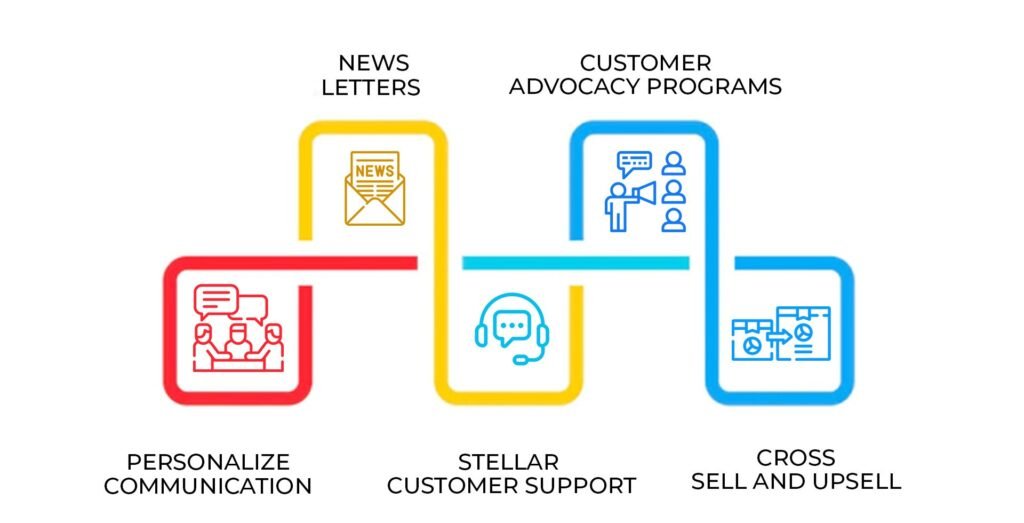
5 Ways How Marketing Automation Helps in Customer Retention
Introduction
Your marketing efforts shouldn’t stop as soon as a new customer makes her first purchase. In fact, it’s quite the opposite. Whenever you gain new customers, you should focus your attention on nurturing that relationship to build customer retention and loyalty.
There comes customer retention! It encompasses all the actions and efforts that go into earning repeat customers. Just because you’ve converted your lead into the customer, you can’t take a rest. Your job now is to ensure that those existing customers continue to buy products or services from your business.
To make your job easy, there’s a single tool that automatically analyzes your customer data, derives insights from them, acts on those insights in real-time, and streamlines your workflow consistently etc. All thanks to the advent of marketing automation.
Marketing Automation has played a stellar role in crafting and supporting “aha” moments for digital brands in Saas, eCommerce, IT, Fintech etc. domains alike. Marketing automation tools help marketers to unload some of their most time-intensive tasks and provide extra time to focus on innovative ideas and strategies to grow and retain their active customer base.
What is Customer Retention?
Customer retention is a metric that measures customer loyalty, or the ability for an organization to keep its customers over time. In addition to identifying the number of loyal customers, customer retention can reflect or predict customer satisfaction, repurchase behavior, customer engagement and emotional ties to a brand.
While customer relationships typically begin with an initial interaction, customer retention metrics are related to the first purchase made by a customer and include all subsequent interactions. Once customer retention is measured, organizations can use this feedback to perform data analysis on components of customer experience and customer success. For example, if a drop in customer retention is reported, an organization can use this to help identify the root cause and adjust its product offerings. A right marketing automation partner can help you understand this better.

Why are Old Customers so Important?
Neglecting existing customers in pursuit of new ones is a common mistake. While customer acquisition is important for business growth, meeting the needs of your existing customer base can be just as critical. Clearly because the cost of acquiring new customers is much higher than retaining existing customers. Retained customers are also more likely to engage in word-of-mouth marketing or become brand ambassadors.
Infact, a recent survey found that a mere 5% increase in retention rates can increase your profits by up to 95%. Compared to new customers, repeat customers tend to spend more and are more likely to try your new products. Businesses should therefore work towards building a customer base with trust and loyalty towards their brand, to see their profits increase over time.
So, maintaining customer loyalty is essential to growing your business because retention yields far greater ROI than acquisition. Marketing automation makes it easy to reward your loyal customers and keep them coming back.
How does Marketing Automation Helps in Retaining Old Customers?
From customer acquisition to retention, marketing automation optimizes all of your communication efforts by reducing repetitive and time-consuming tasks, thus freeing up time and resources to focus on more pressing matters that hamper company growth and productivity.
To give you a clearer picture, it helps you design a closed-loop marketing campaign by integrating and collecting insights for lead generation. Marketing automation takes care of all the legwork for you – data analysis, audience segmentation, personalization, execution, analysis and reporting, leaving you time to plan targeted email campaigns for your prospects and existing customers. Let’s have a look at what all ways marketing automation boosts customer retention.
5 Ways How Marketing Automation Helps in Customer Retention.

1. Personalize Communication
It is found that targeted communications that customers find relevant to them lead to greater loyalty and can increase revenue growth by 10 to 30%. Foregoing that gain leads to huge amounts of money left on the table. Marketers are aware of that, which is why most of the marketing leaders make a point of using marketing automation to create a personalized customer experience.
Without automation, creating personalized content becomes a huge, time-consuming project. But having the right personalisation and automation strategy in place enables you to effortlessly deliver the right offer to the right customer at the right time, on the right channel.
Its predictive, data-driven product recommendations bring up the items that match your customer’s needs and tastes. Working off real-time response to your customers’ activity, it will identify when there is a signal of interest in buying and send out the message on the most effective medium for that particular customer.

2. Newsletters
You can deploy automation tools to generate newsletter content. The newsletter content can take various forms, including product updates, occasional tips or advice, blog content, special offers, announcements of approaching events etc. Distributing newsletters regularly will help you engage customers with your brand.
3. Stellar Customer Support
A study shows that 82% of customers have left a company because of a bad customer service experience.
Your customers expect fast and accurate response to their queries, and they deserve it too. When you have a huge user base it becomes difficult for your customer success team to respond to all of their queries immediately and to keep an eye out for any issue the user may be sharing elsewhere. This is where marketing automation steps in.
Arrange for a live chat support system to respond to visitors and customers to reduce the initial response time. Set an automated response whenever your team is not online.

4. Customer Advocacy Programs
Customer advocacy program is a customer-centric strategy that can be integrated into your marketing plan easily. You can leverage your most loyal customers as brand ambassadors through surveys and referrals to build awareness and trust, drive sales and strengthen customer relationships. Having a customer advocacy strategy can be a game-changer for a business that is trying to stand out.
By collecting customer feedback you will gain all sorts of insights into what your customers want and expect from you. It could be faster delivery, better communication or improved customer experience. Matching customer feedback with your business’s data will help you achieve a much clearer picture of the situation, improve your customer experience and go after the right opportunities.
Similarly, identifying a dip in numbers and receiving negative feedback from your customers could help you to quickly understand where your business needs to invest more time and effort to improve the experience for future customers. You can gather this feedback by using a survey, asking for reviews, reaching out directly and gleaning insights from user activity from your analytics.
5. Cross Sell and Upsell
Automation has revolutionized the buyer journey and is turning the practice of targeting customers into an increasingly precise act. And while on the one hand the online buyer experience becomes progressively personalized. The data from automated systems helps companies to predict customers’ needs without them having to ask, and with this new change, sales methods such as cross-selling and upselling have transformed and evolved too.
Upselling and cross-selling are two terms that are often muddled. A classic upsell is the offer of a more feature-rich alternative to make a sale more profitable. Cross-selling, meanwhile, is the offer of complementary or related products and services. Upsells and cross-sells can account for as much as 30% of your annual revenue – if managed properly.
To boost sales and increase your revenues, you may need to consider adopting upsell and cross-sale into your marketing campaigns. You can hyper personalize recommendations based on the data aggregated through different communication touchpoints and buying behavior of the past. A well honed upsell/crossell strategy can not only boost your toplines, but also deliver “aha” moments to turn your customers into loyal brand advocates.
Wrapping Up
It is clear that the key to high customer retention is, of course, their satisfaction with your products or service, which can be achieved also with well-planned, personalized communication, conducted with the care of customers’ preferences across all stages of their lifecycle.
A sustainable and healthy relationship with the customers is only possible when you start considering each of these leads as individual entities with unique challenges and needs, and engage with them accordingly. It’s not an easy feat, but with marketing automation, you can simplify the whole process, work smarter, reduce wastage, save time and increase productivity. It improves customer retention when implemented in a customer lifecycle marketing approach.
Need help? Get in touch with our marketing automation consultant today and start focusing on end-to-end customer experience and providing value throughout the customer journey.



